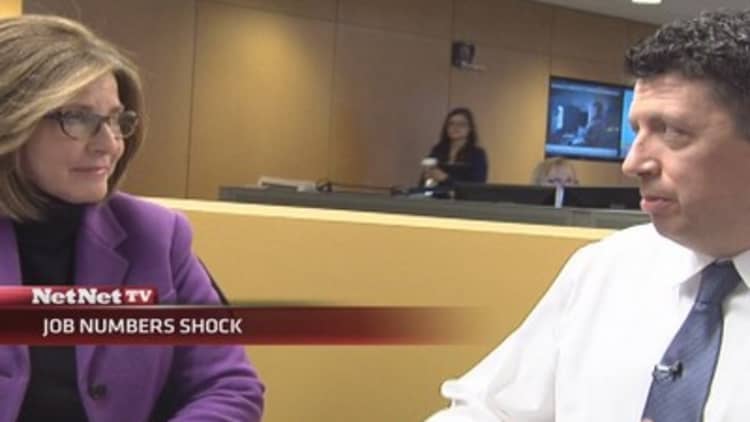
Job creation stumbled in December, with the economy adding just 74,000 positions even as the Federal Reserve voted to take the first steps in eliminating its stimulus program.
The unemployment rate dropped to 6.7 percent, below economist estimates and due primarily to continued shrinkage in the labor force. The labor force participation rate tumbled to 62.8 percent, its worst level since January 1978.
(Read more: Op-ed: Bad jobs report? Don't worry about it)
The monthly job creation was the worst in nearly three years and well below the upwardly revised 241,000 in November.
Economists had expected the economy to add 200,000 jobs in December, with the unemployment rate holding steady at 7.0 percent.
A broader measure of unemployment that includes discouraged and underemployed workers held steady at 13.1 percent.
Economists Mark Zandi and Austan Goolsbee said on CNBC that the numbers shouldn't be taken seriously and likely will be revised higher in future counts.
(More: Chart of the Day: The real unemployment rate?)
"A gain of only 74,000 new jobs in December stands in contrast to the strengthening posted in other major economic data, suggesting the dip in hiring might prove temporary," Kathy Bostjancic, director of macroeconomic analysis at The Conference Board, said in a statement.
Consensus seemed to get around a theory that some rough December weather dampened hiring.
"It's hard to build a house or office building when it's 15 or 20 below. You physically can't do it," Labor Secretary Tom Perez said on CNBC. " Because the materials in that cold weather don't stick, so weather is undeniably a factor."
(Read more: Jack Ablin: Why it may be time to raise the minimum wage)
Those not at work due to bad weather numbered 273,000 for the month, some 92,000 above the five-year average, analysts at Strategas said in a report. Even adding those workers in, though, leaves the number well below consensus.
One other notable condition: The reference point for the report was the week ended Dec. 12, which showed jobless claims spiking to 380,000. Claims have declined since then and the week was written off to "seasonal distortions" that likely worked their way into Friday's report, Bespoke Investment Group said in a note.
Markets had been anticipating a good number before the release,and stocks turned negative in morning trade.
Click here for market reaction.
If stocks finish lower Friday, it would break an eight-month winning streak on "Jobs Friday."
Fed policy has been contingent on two factors—a declining unemployment rate and low inflation. The central bank in December voted to cut its monthly quantitative easing program by $10 billion to $75 billion a month. Outgoing Chairman Ben Bernanke has said that a 7.0 percent unemployment rate would serve as a rough guidepost for cutting the asset purchases, while 6.5 percent would be a benchmark for when to consider raising rates.
Fed economists have recommended, however, that the threshold be lowered to 6.0 percent or even 5.5 percent.
(Read more: Rubio: This is why lower-income workers are stuck)
The numbers immediately sparked debate over whether the Fed would continue to pare back or reconsider.
"The economy, based on any number of other indicators, has been picking up steam of late which makes today's number ... curious," said Dan Greenhaus, chief market strategist at BTIG. "We aren't sure how the Fed should react to this number but we think another reduction at the January FOMC meeting is probably unlikely. Investors though have already cast their vote; bad news is bad news."
(Read more: )
The data indeed have been stronger, with ADP reporting private job growth in December at 238,000. Weekly jobless claims have been consistently below 350,000 and Institute for Supply Management indicators also have pointed to stronger hiring.
But the combination of a declining labor force and a structural unemployment issue in which employers are reluctant to add jobs has made the labor dynamic more difficult to decipher, both for the markets and the Fed.
(Read more: Private job creation is 'off and running': ADP)
"The discrepancy in the skills gap is huge," said Tom Gimbel, CEO and president of LaSalle Network, a Chicago-based staffing firm. "I'm dealing with a thousand companies in Chicago and a few outside of Chicago that are looking to hire people and the skills are not there."
Congress also has been wrestling with the problem as it debates whether to extend emergency unemployment benefits.
Gimbel said the program has been another detriment to resolving the jobs problem.
"The long-term unemployed would rather be unemployed than take a job for considerably less money than what they were making before," he said. "The jobs are there for people willing to take a lower-paying job."
Retail showed the strongest gains for the month as holiday shopping kicked into gear, with 55,000 new positions.
The retail growth suggested that "retailers are finally accepting that they need bodies on the shop floor and in warehouses and perhaps that they are warming to future prospects," Andrew Wilkinson, chief market analyst at Interactive Brokers, said in a note.
Professional and business services added 19,000 while manufacturing grew 9,000.
—By CNBC's Jeff Cox. Follow him on Twitter @JeffCoxCNBCcom.
Correction: This version corrected that the job creation total was the lowest in nearly three years.


